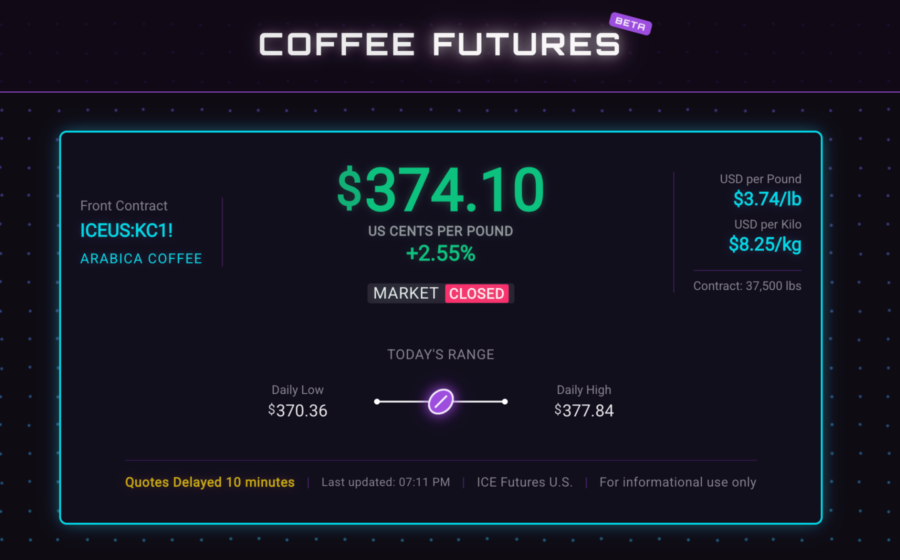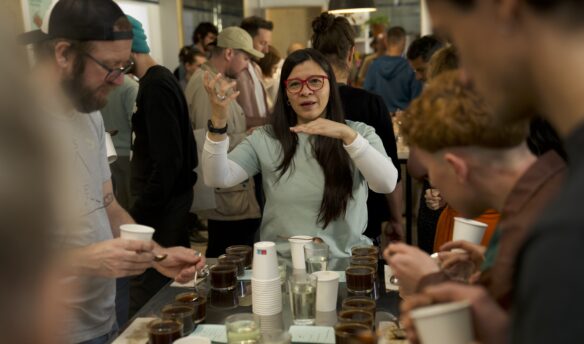The majority of coffee is traded on the commodity market, known as the C Market. Think of it like a stock market: Every day, the price of coffee on the C Market goes up and down. Buyers and sellers use the C Market to determine futures contracts—in other words, they agree on an advance price for coffee that is received later.
Sound confusing? Well, coffee futures just became easier to understand, thanks to Futures.Coffee, a new website from coffee consultant and educator Sandra Loofbourow and her partner, software developer Tom Schluep. The duo launched Futures.Coffee last week as a passion project to democratize an overly complicated and esoteric system.
The free website simplifies C Market pricing for arabica coffee, listing one current price per pound in U.S. dollars. Daily futures contract pricing, high and low prices, and volume of coffee traded are all prominently displayed as well. Additional tabs include charts tracking pricing history, foreign exchange rates, and the latest coffee market news.
Loofbourow says Futures.Coffee is a way to distill C Market information more easily. “Coffee is ultimately a commodity and traded against futures market pricing,” Loofbourow says. “The more people are aware of what’s happening in the C Market, the more information we have about what coffee costs and why.”
She notes that while many in the specialty industry pay more for coffee than the C Market price, it’s still often used as a benchmark. “Even for us in the specialty industry who strive to work outside of the commodities market, all of our transactions are determined by C Market pricing whether we want to accept that or not,” she says.
Simplifying the C Market Price
Schluep spent about four months designing the site on nights and weekends, creating a tool so that individuals without a finance background could easily understand the C Market price and timeline. For example, on May 13, the market low was $372.59, and the high was $380.11. The market closed at $376.35. The site is easy to check on your phone, or even display on a giant dashboard in an office or roasting lab.
“If you search for this information now, and click on one of the top websites like Bloomberg or Barchart, it’s not well-organized,” Schluep says. “It’s a lot of numbers and a lot of data, and it can be overwhelming. We source the same data that is publicly available and make it a little more approachable and legible.”
Loofbourow and Schluep stress that Futures.Coffee isn’t a trading platform, but it is updated several times an hour when the market is open.
“There are plenty of people who are aware of the coffee industry and the economics of trade in the world, and want to have an understanding of why your coffee is more expensive than it used to be without getting into the minutiae,” Loofbourow says. “It paints a better picture for the consumer and producer about why things are the way that they are without having to be an expert in economics or trade.”
Schluep says that they had more than a thousand users in the first week, which exceeded expectations, and the duo are excited to launch additional features in coming months. For example, the site currently only tracks the C Arabica Market, which is traded in New York. They are now working on adding the C Robusta Market, which is traded in London (by the ton instead of by the pound).
Ultimately, Futures.Coffee makes information more accessible for all actors in the coffee supply chain. Traditionally, bigger importers and traders had more information than smaller players. Consumers, meanwhile, have historically had very little understanding of what contributes to coffee prices at their local cafes. Loofbourow and Schluep are hoping to address those imbalances.
“If we all have easier access to the information then we can make better decisions,” Loofbourow says. “The intent here is just to prevent information asymmetry as much as possible.”
















